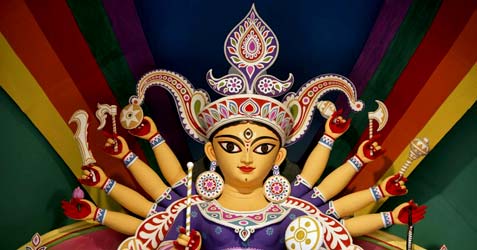
In Hinduism Durga is the consort of Lord Shiva and the principal form of the Mother Goddess. She is worshipped by many names such as Amba, Ambika, Jagadamba, Parvathi, Shakti, Adishakti, Adi Parashakti and Devi. According to the Hindus, Goddess Durga is considered as the creation, sustenance and annihilation.
She is also known as Uma, "light"; Gauri, "yellow or brilliant". She is a form of energy or Shakti or the "Invincible One". She is a symbol of female dynamism and represents the mother of Universe. Goddess Durga is worshipped during the festival of Durga Puja every year in all over India especially popular in West Bengal and Tripura among the Bengalis.
According to the Puranas and Agamas, Durga is described as endless aspects and the iconography consequently varies. Riding a lion “Simhavahini” she is pictured having ten arms holding Sword, Conch, Discus, Rosary, Bell, Winecup, Shielf, Bow, Arrow, and Spear.
She is a beautiful warrior and stories suggests armed with celestial and powerful weapons gifted by the deities dressed in royal red cloth and has several ornaments decorating her personage. Goddess Durga rode into the battle field and challenged the Buffalo Daemon Mahishasur. After a long fight Durga flung her trident and beheaded Mahishasur, finally killing him.
Goddess Durga has been worshipped from about 400 AD. The Ramayana and The Mahabharata epic and Puranic texts are the literary references of her and she is also mentioned in the vedic literature.
Every year she comes for 9 days in her mother’s home. Goddess Durga is perhaps worshipped and observed in her honor, to celebrate the victory over evil mainly at the State of West Bengal during the Durga Puja.